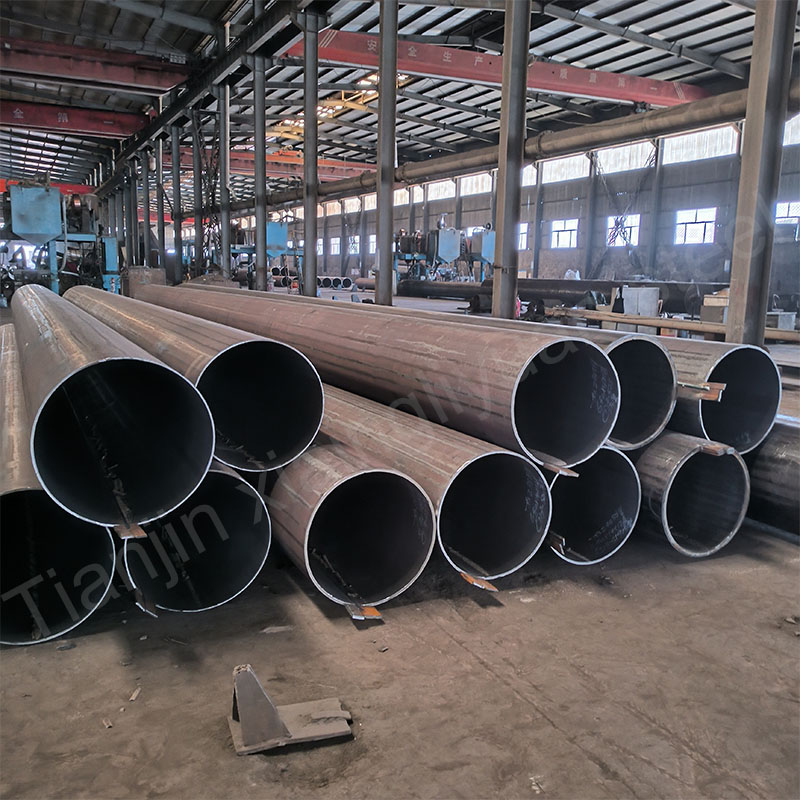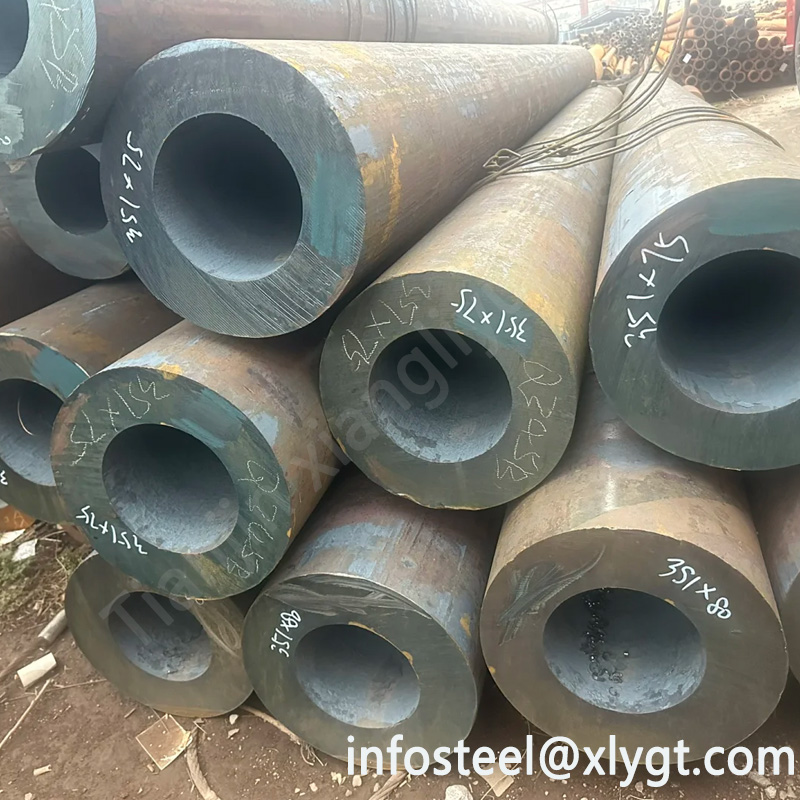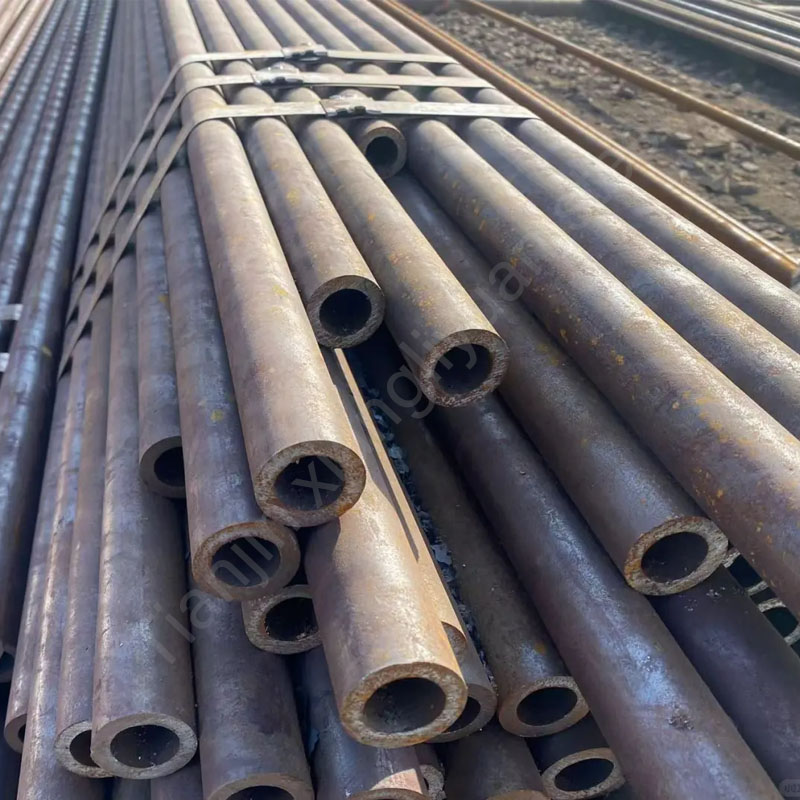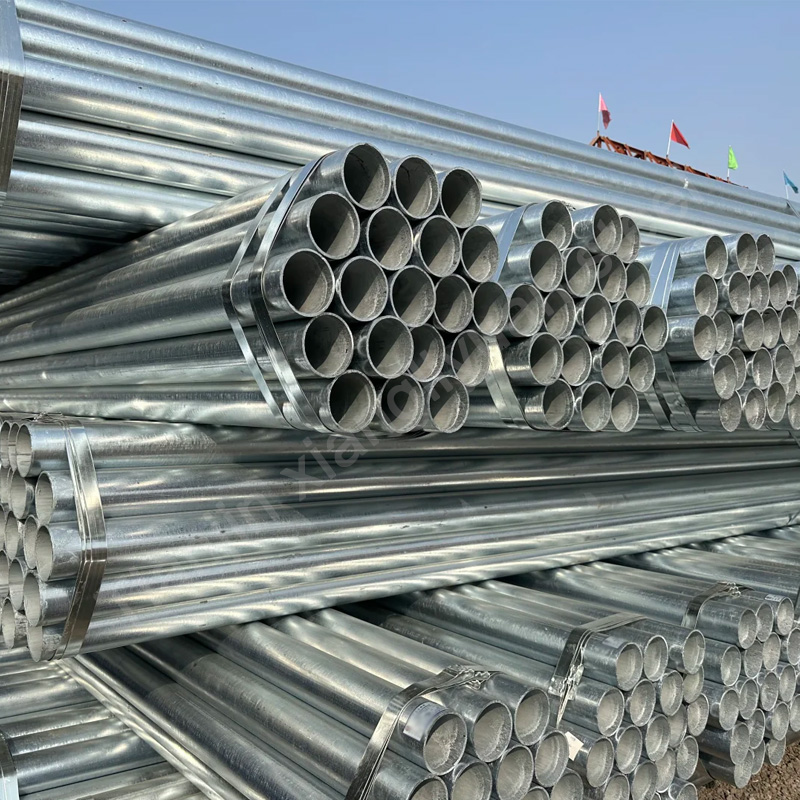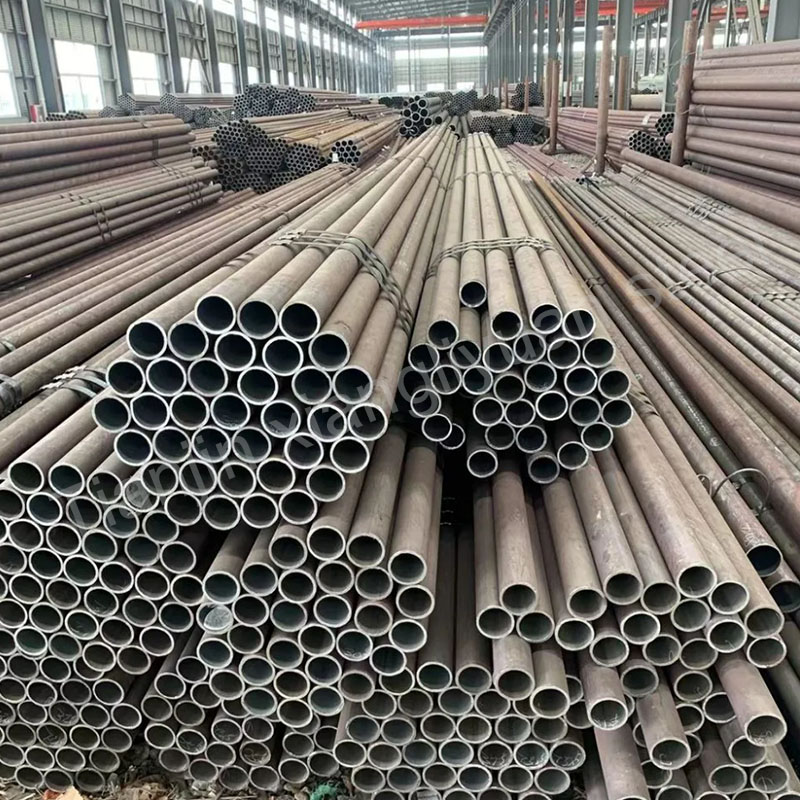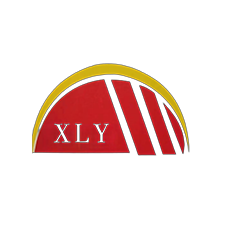A straight seam steel pipe is a steel pipe with a weld parallel to the longitudinal direction of the steel pipe. It is usually divided into metric electric welded steel pipe, electric welded thin-walled pipe, transformer cooling oil pipe, etc. The production process of straight seam welded pipe is simple, with high production efficiency, low cost and rapid development. The strength of spiral welded pipe is generally higher than that of straight seam welded pipe. It can produce welded pipes with larger diameters with narrower billets, and can also produce welded pipes with different diameters with billets of the same width. However, compared with straight seam pipes of the same length, the weld length increases by 30~100%, and the production speed is lower.
Generally, welded pipes are used to transport low-pressure fluids. Made of Q195, Q215A, Q235A steel, and Q235B plain carbon. It can also be made of easy-to-weld 0317 standard model 6012 and steel mother 755 mild steel. Steel pipes must undergo water pressure, bending, flattening and other experiments, and have certain requirements for surface quality. Usually the delivery length is 4-10m, and fixed length (or multiple length) delivery is often required. The specifications of welded pipes are expressed in nominal diameter (mm or inches). The nominal diameter is different from the actual diameter. According to the specified wall thickness, welded pipes are divided into ordinary steel pipes and thickened steel pipes. According to the pipe end form, steel pipes are divided into threaded and non-threaded.
The welding process used for submerged arc welded straight seam steel pipes is submerged arc welding technology, which uses filler welding and particle shielded flux submerged arc. The production diameter can reach 1500mm. LSAW is the English abbreviation for submerged arc welded straight seam steel pipes. The production processes of submerged arc welded straight seam steel pipes include JCOE forming technology and coil forming submerged arc welding technology. When the diameter is large, two steel plates may be used for coiling, which will form a double weld. The standards that can be implemented are GB/T3091-2008 low-pressure fluid steel pipe production standard, GB/T9711.1-2 -1997 petroleum and natural gas steel pipe production and use standard, and the American API 5L pipeline steel pipe implementation standard. Production materials: Q195A-Q345E; 245R; Q345QA-D; L245-L485; X42-X70. The main pressure parameters are 2ST/T, S is the yield strength, T is the wall thickness. Submerged arc welding has developed into double-wire submerged arc welding and multi-wire submerged arc welding, and the efficiency is further improved.
Production process of straight seam steel pipe
According to the production process, straight seam steel pipes can be divided into high-frequency straight seam steel pipes and submerged arc welding straight seam steel pipes. Submerged arc welding straight seam steel pipes are divided into UOE, RBE, JCOE steel pipes, etc. according to their different forming methods. The following introduces the most common high-frequency straight seam steel pipes and submerged arc welding straight seam steel pipe forming processes.
Submerged arc welding process
Plate inspection: After the steel plate used to manufacture large-diameter submerged arc welding straight seam steel pipe enters the production line, it is first subjected to full-plate ultrasonic inspection;
Edge milling: The two edges of the steel plate are double-sided milled by the edge milling machine to achieve the required plate width, plate edge parallelism and groove shape;
Pre-bending edge: The plate edge is pre-bent by the pre-bending machine to make the plate edge have the required curvature;
Forming: First, half of the pre-bent steel plate is pressed into a “J” shape through multiple step punching on the JCO forming machine, Then bend the other half of the steel plate in the same way, press it into a “C” shape, and finally form an open “O” shape
Pre-welding: make the formed straight seam welded steel pipe close and use gas shielded welding (MAG) for continuous welding;
Inner welding: use longitudinal multi-wire submerged arc welding (up to four wires) to weld on the inside of the straight seam steel pipe;
External welding: use longitudinal multi-wire submerged arc welding to weld on the outside of the straight seam submerged arc welded steel pipe;
Ultrasonic inspection I: conduct 100 % inspection;
X-ray inspection I: 100% X-ray industrial television inspection of internal and external welds, using image processing system to ensure the sensitivity of flaw detection;
Expansion: Expand the entire length of the submerged arc welded straight seam steel pipe to improve the dimensional accuracy of the steel pipe and improve the distribution of stress in the steel pipe;
Hydraulic pressure test: Inspect the expanded steel pipes one by one on the hydraulic pressure testing machine to ensure that the steel pipes meet the test pressure required by the standard. The machine has automatic recording and storage functions;
Chamfering: Process the pipe ends of the steel pipes that have passed the inspection to achieve the required pipe end groove size;
Ultrasonic inspection II: Ultrasonic inspection is performed again one by one to check the defects that may occur in the straight seam welded steel pipes after expansion and water pressure;
X-ray inspection II: X-ray industrial television inspection and pipe end weld filming of the steel pipes after expansion and water pressure test;
Tube end magnetic particle inspection: This inspection is performed to find tube end defects;
Anti-corrosion and coating: The qualified steel pipes are anti-corrosion and coated according to user requirements.
Differences between spiral submerged arc welded steel pipe and straight seam steel pipe
Since the 1930s, with the rapid development of high-quality strip steel continuous rolling production and the advancement of welding and inspection technology, the quality of welds has been continuously improved, the varieties and specifications of welded steel pipes have increased, and they have replaced seamless steel pipes in more and more fields. Welded steel pipes are divided into straight seam welded pipes and spiral welded pipes according to the form of welds. The production process of straight seam welded pipes is simple, the production efficiency is high, the cost is low, and the development is rapid. The strength of spiral welded pipes is generally higher than that of straight seam welded pipes. Narrower billets can be used to produce welded pipes with larger diameters, and billets of the same width can also be used to produce welded pipes with different diameters. However, compared with straight seam pipes of the same length, the weld length increases by 30~100%, and the production speed is lower. Therefore, smaller diameter welded pipes are mostly welded by straight seam welding, while large diameter welded pipes are mostly welded by spiral welding.
Spiral seam submerged arc welded steel pipe for general low-pressure fluid transportation (SY5037-2000) is made of hot-rolled steel strip coil as pipe blank, spirally formed at room temperature, and made by double-sided automatic submerged arc welding or single-sided welding. It is used for general low-pressure fluid transportation such as water, gas, air and steam.
Spiral seam high-frequency welded steel pipe for general low-pressure fluid transportation (SY5039-83) is made of hot-rolled steel strip coil as pipe blank, spirally formed at room temperature, and welded by high-frequency lap welding for spiral seam high-frequency welded steel pipe for general low-pressure fluid transportation.
Spiral welded steel pipe for piles (SY5040-2000) is made of hot-rolled steel strip coil as pipe blank, spirally formed at room temperature, and made by double-sided submerged arc welding or high-frequency welding. It is used for foundation piles of civil engineering structures, docks, bridges, etc.
Welded steel pipe for low-pressure fluid transportation (GB/T3092-1993) is also called general welded pipe, commonly known as black pipe. It is a welded steel pipe used for conveying generally low-pressure fluids such as water, gas, air, oil and heating steam and other purposes. The wall thickness of the steel pipe joint is divided into ordinary steel pipe and thickened steel pipe; the pipe end form is divided into non-threaded steel pipe (plain pipe) and threaded steel pipe. The specifications of the steel pipe are expressed in nominal diameter (mm), which is the approximate value of the inner diameter. It is usually expressed in inches, such as 11/2. In addition to being directly used to convey fluids, welded steel pipes for low-pressure fluid transportation are also widely used as the original pipes of galvanized welded steel pipes for low-pressure fluid transportation.
Galvanized welded steel pipes for low-pressure fluid transportation (GB/T3091-1993) are also called galvanized electric welded steel pipes, commonly known as white pipes. It is a hot-dip galvanized welded (furnace welded or electric welded) steel pipe used for conveying generally low-pressure fluids such as water, gas, air oil, heating steam, warm water, etc. or other purposes. The wall thickness of the steel pipe joint is divided into ordinary galvanized steel pipe and thickened galvanized steel pipe; the pipe end form is divided into non-threaded galvanized steel pipe and threaded galvanized steel pipe. The specifications of the steel pipe are expressed in nominal diameter (mm), which is the approximate value of the inner diameter. It is usually expressed in inches, such as 11/2, etc.
Ordinary carbon steel wire casing (GB3640-88) is a steel pipe used to protect wires in electrical installation projects such as industrial and civil buildings, installation of machinery and equipment.
Straight seam electric welded steel pipe (YB242-63) is a steel pipe with the weld parallel to the longitudinal direction of the steel pipe. It is usually divided into metric electric welded steel pipe, electric welded thin-walled pipe, transformer cooling oil pipe, etc.
Spiral seam submerged arc welded steel pipe for pressurized fluid transportation (SY5036-83) is a spiral seam steel pipe for pressurized fluid transportation, which is made of hot-rolled steel strip coil as pipe blank, spirally formed at room temperature, and welded by double-sided submerged arc welding. The steel pipe has strong pressure bearing capacity and good welding performance. It has been subjected to various rigorous scientific inspections and tests, and is safe and reliable to use. The steel pipe has a large diameter, high transmission efficiency, and can save investment in laying pipelines. It is mainly used for pipelines for transporting oil and natural gas.
The spiral seam high-frequency welded steel pipe for pressure fluid transportation (SY5038-83) is made of hot-rolled steel strip coils as pipe blanks, spirally formed at room temperature, and welded by high-frequency lap welding. It is a spiral seam high-frequency welded steel pipe for pressure fluid transportation. The steel pipe has strong pressure bearing capacity, good plasticity, and is easy to weld and process; it has been subjected to various rigorous and scientific inspections and tests, and is safe and reliable to use. The steel pipe has a large diameter, high transmission efficiency, and can save investment in laying pipelines. It is mainly used for laying pipelines for transporting oil, natural gas, etc.
The strength of spiral welded pipes is generally higher than that of straight seam welded pipes. The main production process is submerged arc welding. Spiral steel pipes can produce welded pipes of different diameters with the same width of billets, and can also produce welded pipes with larger diameters with narrower billets. However, compared with the straight seam pipe of the same length, the weld length increases by 40%~100%, and the production speed is lower. Therefore, most smaller diameter welded pipes use straight seam welding, while large diameter welded pipes mostly use spiral welding. When producing larger diameter straight seam spiral steel pipes in the industry, T-welding technology is used, that is, short sections of straight seam steel pipes are butt-jointed to form a length that meets the needs of the project. The probability of defects in T-welded straight seam steel pipes is also greatly increased, and the welding residual stress at the T-weld is large. The weld metal is often in a triaxial stress state, which increases the possibility of cracks.
(1) The manufacturing process of spiral steel pipes determines that their residual stress is large. According to relevant foreign data, some are even close to the yield limit. Due to the expansion process, the residual stress of submerged arc welded straight seam steel pipes is close to zero.
(2) The welding tracking of spiral welds and ultrasonic online detection tracking are both difficult. Therefore, the probability of weld defects exceeding the standard is higher than that of straight seam submerged arc welded pipes.
(3) The misalignment of spiral steel pipe welds is mostly 1.1-1.2mm. According to international practice, the misalignment should be less than 10% of the thickness. If the pipe wall thickness is small, the misalignment is difficult to meet the demand, but there is no such problem with submerged arc welded straight seam steel pipes.
(4) Compared with straight seam submerged arc welded pipes, spiral welds have poor streamlines and serious stress concentration.
(5) The heat affected zone of spiral submerged arc welded pipes is larger than that of submerged arc welded straight seam steel pipes, and the heat affected zone is the weak link in the quality of welded pipes.
(6) The geometric dimensional accuracy of spiral seam welded steel pipes is poor, which brings certain difficulties to on-site rotation (such as matching and welding).
(7) For the same diameter, the thickness that spiral seam welded steel pipes can achieve is much smaller than that of straight seam submerged arc welded pipes.

